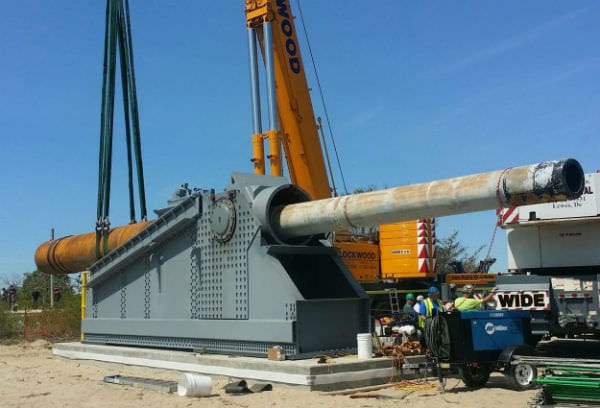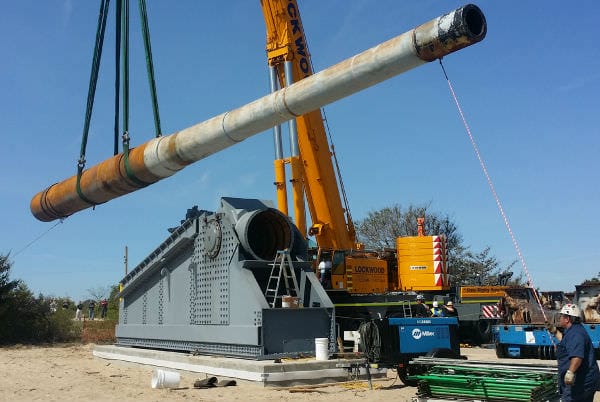16-inch gun which fired 2,700-pound shells was mounted on USS Missouri when Japan surrendered on Sept. 2, 1945 to end the Second World War


Lewes, DE -(AmmoLand.com)- After wartime service in the Pacific aboard the storied “Mighty Mo” – the battleship USS Missouri – one of the ship’s nine original 16-inch guns that shook the enemy fleet with 2,700-pound shells was moved today to a permanent display within historic Fort Miles at Cape Henlopen State Park.
Of yet another historic note, the big gun was mounted on the Missouri when the Japanese surrender was accepted on Sept. 2, 1945, ending World War II.
“The USS Missouri’s gun is an important piece of American history that will draw families and tourists to Fort Miles and the beautiful shores of Cape Henlopen State Park,” said Governor Jack Markell. “Bringing new amenities and historical treasures to our parks not only provides an economic boost to the state, but is one the reasons why Delaware State Parks was recognized nationally this year with the Gold Award as the best park system in the nation.”
Among the largest pieces of U.S. Naval artillery ever made, the 16-inch gun was saved just days before it was to be cut up for scrap and moved by barge and rail from a naval yard in Norfolk to the park by the Fort Miles Historical Association (FMHA). The FMHA raised $113,500 in private donations and received several key grants from the G.M. Foundation, Sussex County Council and the Delaware Department of Economic Development’s Division of Tourism to transport the116-ton, 66-foot-long gun barrel to Delaware.
“The spirit and dedication of the volunteers of the Fort Miles Historical Association is reminiscent of this country’s ‘Greatest Generation’ that built and manned Fort Miles and protected the region during World War II,” said DNREC Secretary David Small. “We are incredibly appreciative of the Association’s efforts to save one of the Missouri’s big guns and bring it to Cape, along with all of the other great things the group has done to restore the fort. The gun is representative of those who were stationed at Fort Miles for coastal defense. Now students, veterans, families, visitors and history buffs can relive an important part of Delaware history surrounded by the buildings and artifacts that will help make that experience come alive.”
“The Fort Miles Historical Association is proud and honored to partner with Delaware State Parks and create this final resting place for the Missouri barrel #371,” said FMHA President Gary Wray. “The barrel is the centerpiece of our Fort Miles Museum which, when completed, will be the best World War II museum inside a World War II facility in the U.S.”
A 90,000-pound concrete base, a 70,000-pound slide, a 38,500-pound yoke and other parts have been assembled in order to create a safe and appropriate gun emplacement for the historic barrel. Funding for placement of the barrel came from state appropriations through DNREC’s Division of Parks & Recreation.

At the fort today, Lockwood Company, subcontractor for the site contractor Kent Construction Co., lowered the freshly-polished barrel onto the concrete pad using a 500-ton crane. The total weight of the permanent display is more than 300 tons. The gun takes its place among other big guns already nestled among the sand dunes at Battery 519.
Fort Miles was a major operational center for U.S. coastal defenses during World War II. The Delaware River was a chief priority for defense planners because of the access it afforded to the large trade centers of Wilmington and Philadelphia. During the war, the fort was equipped with heavy guns, mine fields and searchlights for in-depth defense.
However, the growing use of long-range missiles brought an end to harbor defenses in the U.S., and by 1958, Fort Miles was no longer needed for the defense of the region. In 1964, 543 acres of the base were returned to the state of Delaware, forming the heart of Cape Henlopen State Park. In April, 2005, Fort Miles was added to the National Register of Historic Places.
The new Artillery Park at Fort Miles, which is scheduled to open this summer, will feature more big guns and include a central pathway that will display wayside exhibits that tell the story behind each gun. The park will also feature amenities commemorating the role of the fort during wartime.
The Fort Miles Historical Association is a nonprofit group whose mission is to preserve, protect and defend all aspects of Fort Miles working with community and state stakeholders and other interested parties.
The association’s goal is to work as an active partner with the State of Delaware to develop the historical potential of Fort Miles.
About the Delaware Department of Natural Resources and Environmental Control (DNREC):
DNREC is committed to preserving the quality of Delaware’s environment, maintaining the health and safety of its residents, and protecting the natural systems upon which life depends. DNREC’s Division of Fish and Wildlife’s mission is to ensure that the freshwater, marine and wildlife resources of the State of Delaware will be conserved and managed for equitable and sustainable use.
For more information, visit: www.dnrec.delaware.gov.

Doesn’t make sense, Delaware is a gun grabbing state.
The Mighty Mo just went through a full dry dock procedure from October 2015 till January 2016 where LOTS of things were done. Everything from new paint to repairing badly rusted and leaking spots on the starboard side. The ship remains and will forever remain in the Pearl Harbor monumental area although it can NO longer be registered as a National Historical Monument since during the Gulf War they had to do too much work to bring it up to functional that it lost it’s original historical status BUT it still remains in the monument group charity and is funded… Read more »
Oh brother!!!
Why do people comment before reading previous posted comments that contain the answer? Better yet
just Google a little history on Naval Riffles and Turrets and educate yourself before you come off looking thick.
Sorry but something is way wrong here. I was in HI just a few years ago and all the 16″ guns are still in place. I even have photos of my next to the turret and they are quite in tact. According to the record books she was still firing huge quantities of 2700 pound rounds during the Gulf war as close as 2/25/1991 so how did the gun go from HI to DE and where is the opening in the turret for the now apparently missing gun? The Mo was restored recently but it only took 3 months and… Read more »
The barrels were only good for 200 or so shots before they required replacement. This one wore out in 1945 and was replaced.
PS…Most of the Gun Barrels like this were removed to be re rifled. The Battlewagons had a stock pile of barrels to replace when the rifling was worn.
One of her gun barrels is in Phoenix in Hance park. Next to it is a gun barrel from the Arizona. Start to finish of WWII.
This is a Barrel to one of the 3 guns in a turret, It was most likely removed to be re-sleeved after seeing service and stored in Norfolk if any of the Iowa class ships required a replacement it was available. As a former Battleship sailor ( USS Iowa BB-61 ) I think it is great to see the history maintained But if you really want to see one go see the New Jersey or the Wisconsin both right on the east coast.
Who knew that there were so many people on this site that knew about battle ships. Go Navy! By the way, what does the BB stand for?
Battleship Brigade
Oh, and thank you. Now, I know what a brigade is and I know what a battle ship is, but how do they get battleship brigade?
Like CVN Carrier Vessel Nuclear the DoD tries to use names that represent the function of the item in question. In the case of the Mighty Mo it was the BB type #63 The aircraft carrier Nimitz is CVN 68
UH1 for example is Utility Helicopter typically called the Huey and each one would have a tail number as ships have hull numbers
Thank you Dr. Dave, I know about the UH1 (my favorite ride home), but not the Navy nomenclature. Mucho appreciado.
Not so sure of your designation call outs. BB just straight up designates a Battleship, CA is a cruiser. ‘V’ is for heavier than air, CV, CVA, CVL, CVN, they are carriers of heavier than air craft. Frigate is an FFG. A brigade is more of an infantry term.
I sincerely hope the article is wrong…. years back, the Mo was a publically accessible floating museum part of Puget Sound Naval Base in Bremerton, Washington. Against our wishes, the Missouri was taken from us and sent off to Hawaii to become part of the monument there, along with the sunken Arizona. Now, to read she is being scrapped, and one of her gun barrels is now on a newly made display pedestal is disappoointing to say the least. WHY was she not made available to return to Bremerton? She is missed there. I’m hoping this gun barrel is from… Read more »
I’m confused, the U.S.S. Missouri (BB-63) is anchored at Pearl Harbor Hawaii facing and guarding the Arizona. How and why did a gun get removed? And what does it have to do with Delaware? Something is seriously wrong with this article. I suspect it isn’t from the Missouri at all but another ship. BTW, Missouri saw action in WW2, Korea and the Gulf War but not Vietnam; that was U.S.S. NewJersey.
The 16″/50 Mk7 gun had a firing life of about 250 – 300 rounds. After that they had to be removed to have their rifled liner replaced. The Navy always kept extra guns on hand so that they could simply be swapped out when it came time for re-lining.
It is likely that that gun saw service on more then one Iowa class battleship. Large naval guns barrels like that aren’t like what you would see on a rifle or pistol. They what is called a “built-up gun” the barrel is composed of multiple layers of steel. At its center is a rifled liner that is only good for around 300 rounds (smaller guns = longer life). At that point the entire gun, minus the breech assembly, is removed and replace with a fresh barrel while the old one is sent off to have its current liner rammed out… Read more »
Like everything they wear out and need to be replaced… You can only fire so many shells before the barrells have to be replaced
Barrels are not the original nes when the ship was built.. They have to replace the barrels after so many shells have been fired due to wear and tear
would be nice to see a picture of it mounted on the Missouri. Was this barrel in one of the three-barreled pivoting turrets?
I’ll pass. I couldn’t afford to shoot the darn thing. But I’m glad they saved it. Too many historical items get scrapped.
Why and when we’re the guns taken off the Mo ? That the Mo saw action in Vietnam too.
THAT IS MAN SIZE RIGHT THERE ! 2700lb.shells ! Damn !